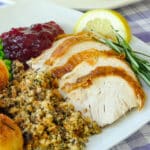Print


Lemon Rosemary Brined Roasted Turkey
Prep Time 20 minutes
Cook Time 2 hours
Total Time 2 hours 20 minutes
Servings 10 servings
Calories 555 kcal
Ingredients
- 10-15 pound fresh turkey
For the Brine Mixture
- 6 quarts or liters of very cold water A little more if needed to cover the turkey completely
- 1/2 cup table salt
- 1/2 cup brown sugar
- 1/4 cup honey
- 6 sprigs fresh rosemary
- 2 large sliced onion
- 4 cloves garlic sliced thin
- zest and juice of two large lemons
- 6 tbsp whole black peppercorns
Aromatics to place in the turkey cavity while roasting
- 1 onion quartered
- 2 cloves garlic sliced
- 1 whole lemon stabbed with a fork several times
- 2 sprigs rosemary
Instructions
-
You will need a food grade plastic bucket or large pan, big enough to completely submerge the turkey in the brine for this recipe.
To prepare the brine.
-
Add the salt, sugar and honey to the water Stir well to completely dissolve the sugar and salt.
-
Add 1 liter of this mixture to a pot along with the rosemary, onion, garlic, lemons & peppercorns.
-
Simmer for just 5 minutes before returning it to the rest of the brine mixture.
-
Wash the turkey well and completely submerge the turkey in the bucket of brine. A plate with a couple of heavy cans of tomatoes or beans placed over the turkey will help keep it submerged. Place in the refrigerator for 24-236 hours depending on the size of the turkey. I remove one of the shelves in the fridge to fit my bucket in.
-
After brining the turkey, remove it from the brine and pat it dry with paper towels. Place on a rack in a roasting pan, truss the turkey with butcher twine (or just tuck the wing tips in under the turkey and tie the legs together to simplify things.) There is no need to add additional salt or pepper, the brine has already seasoned the meat throughout. Rub the surface of the turkey with a couple of tablespoons of butter.
-
To the cavity add the onions, garlic, lemon and rosemary as noted in the Aromatics list above.
-
Do not cover the turkey. Open roast the turkey in a preheated 400 degree F oven for 1/2 an hour before reducing the temperature to 350 degrees F.
-
Brush the turkey with melted butter about every 30-45 minutes to get a nicely browned skin.
-
After reducing the heat, continue roasting for about an additional 2 hours or until the internal temperature of the thickest part of the breast meat reaches 180 degrees F on a meat thermometer; this could be more or less time depending on the actual size of the turkey you are roasting. Using a meat thermometer is the best way to make sure your turkey is completely and safely cooked. Remove from oven and loosely cover with aluminum foil and allow the turkey to rest for 20 - 30 minutes before carving. This resting period is ESSENTIAL!
-
NOTE: Although it is traditional in Newfoundland cooking to roast a turkey in a covered roaster, this is a sure way to ensure a dry, overcooked turkey. I NEVER roast a turkey covered, always leaving it to open roast in the oven. This crisps the skin and seals in all the natural juices, creating a turkey that bastes in its own juices. I also ALWAYS use a meat thermometer to test if the turkey is cooked. Open roasting as well as getting the meat to 180 degrees F and properly resting the turkey before carving, is the best way to prepare a juicy, succulent turkey. If you don't own a meat thermometer, you should. It is the safest way to ensure poultry is fully cooked and very useful for getting that perfect medium rare prime rib roast beef too; it's a kitchen essential for sure.
-
After the turkey has rested, I still make gravy from the pan drippings and my own frozen turkey stock that I always have on hand, made from the carcass of my last roast turkey. I ALWAYS use stock and not water to make the best gravy. Low sodium or no-salt-added store bought turkey or chicken stock are also good options if you don't have your own homemade stock available but be sure to make some from the remnants of this turkey and freeze in plastic containers for soup or to make the most delicious turkey gravy next time. I still thicken my gravy the way my grandmother did with a slurry of flour and water. I despise corn starch thickened gravy; you will never find it at my house.